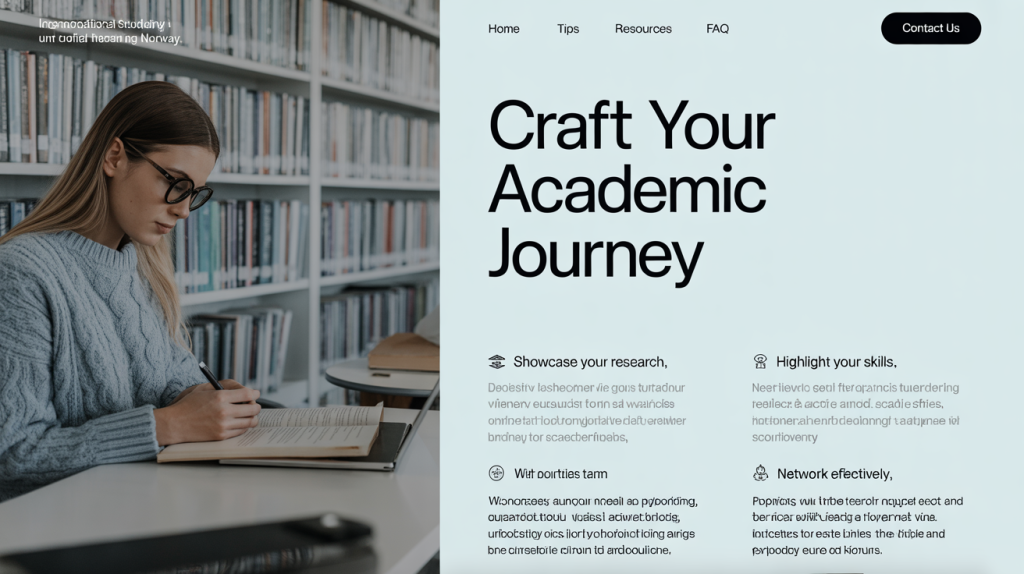How to Build an Impressive Academic Portfolio While Studying in Norway
Quick Navigation
- Understanding the Programme Structure and Requirements
- Documenting Your Achievements and Progress
- Leveraging Norway’s Quality Assurance and Institutional Support
- Meeting Formal and Preparatory Requirements
- Seeking Diverse Academic and Extracurricular Experiences
- Summary: Building an Impressive Academic Portfolio in Norway
- Take the Next Step with Study in Norway
Understanding the Programme Structure and Requirements
A fundamental step in building an impressive academic portfolio is to thoroughly understand the structure and learning outcomes of your study programme. Norwegian universities design their curricula with clear expectations and outcomes, so aligning your portfolio with these criteria is essential.
- Familiarize Yourself with Learning Outcomes: Each programme is centered around specific competencies and knowledge goals. Reviewing these outcomes helps you plan your coursework, projects, and supplementary activities accordingly.
- Utilize Portfolio Templates and Programme Guides: Most Norwegian institutions provide students with tools such as portfolio templates and detailed course guides. These resources enable you to track credits, course content, and skill development efficiently.
- Map Academic Progress: Use these tools to connect your activities with the required learning outcomes. This structured approach ensures that your portfolio reflects not only the quantity but the quality and relevance of your academic work.
Studying the academic portfolio guidelines provided by your institution will give you clarity on expected standards and help you plan your documentation effectively.
Documenting Your Achievements and Progress
Creating an impressive academic portfolio relies heavily on thorough and well-organized documentation. Being proactive in collecting evidence of your academic journey will set your portfolio apart.
- Maintain Detailed Records: Keep copies of coursework, research papers, project reports, and any presentations or assignments. Consider organizing these documents by semester or subject area.
- Incorporate Visual Evidence: Norwegian universities often recommend visual aids such as charts, competency matrices, or tables to showcase learning progress and acquired skills clearly.
- Record Additional Academic Activities: Workshops, seminars, and other extracurricular learning experiences should be documented with certificates or attendance proofs.
- Include Research and Internship Outcomes: If you are involved in research projects or internships, gather supervisor feedback, certificates of completion, and any publications or presentations resulting from your involvement.
A portfolio rich in diverse, verifiable materials will impress academic committees and recruiters alike by demonstrating your commitment and range of competencies.
Leveraging Norway’s Quality Assurance and Institutional Support
Norway’s higher education system maintains high standards through continuous quality assurance and institutional support mechanisms. International students can benefit significantly by engaging with these processes.
- Participate in Feedback and Development Processes: Many universities encourage students to give feedback on courses and curricula. Active involvement demonstrates initiative and can be an enriching addition to your portfolio.
- Stay Updated on Academic Portfolio Developments: Faculties often revise portfolio requirements or introduce new programmes. Keeping yourself informed about these changes and participating in planning discussions when possible signals engagement and leadership.
- Engage in Quality Assurance Initiatives: Being a part of committees or forums related to teaching quality and programme development adds a layer of professionalism and strategic awareness to your profile.
These activities not only improve your academic experience but enhance the content and impact of your portfolio, highlighting your proactive role in your education.
Meeting Formal and Preparatory Requirements
An impressive portfolio must clearly document that you have met all formal academic, language, and preparatory requirements essential for studies in Norway.
- Fulfill Academic Criteria: Ensure all credits, exams, and course requirements are completed and properly recorded.
- Provide Language Proficiency Documentation: English language proficiency (or Norwegian if applicable) should be documented according to programme requirements.
- Maintain Official Records: Keep copies of diplomas, transcripts, and certificates as part of your portfolio for reference in future applications or assessments.
You can find detailed information on academic and language requirements on the Study in Norway requirements page, which is a valuable resource for maintaining a complete portfolio.
Seeking Diverse Academic and Extracurricular Experiences
To build a portfolio that truly stands out, consider expanding your educational experience beyond mandatory coursework.
- Engage in Exchange Programmes: Studying abroad or participating in exchange programmes broadens your perspective and adds international depth to your portfolio.
- Join Research Groups and Student Societies: These opportunities enhance your teamwork, leadership, and research skills.
- Contribute to Programme Development Forums: Authentic involvement with institutional development reflects a high level of commitment and professionalism.
Exploring these avenues demonstrates versatility and a readiness to adapt and grow—qualities highly regarded in the competitive international education and recruitment landscape.
Summary: Building an Impressive Academic Portfolio in Norway
To recap, building an impressive academic portfolio while studying in Norway involves:
- Aligning your academic activities with clearly defined learning outcomes through structured programme guides and templates.
- Maintaining meticulous documentation of coursework, projects, workshops, research, and internships, including visual representations of your competencies.
- Actively engaging in Norway’s quality assurance initiatives and institutional processes to highlight your involvement and leadership.
- Meeting all formal academic and language requirements, ensuring your portfolio is comprehensive and verifiable.
- Pursuing diverse curricular and extracurricular experiences to show initiative, adaptability, and well-rounded development.
By leveraging Norway’s transparent and quality-driven academic environment, you can compile a portfolio that is thorough, relevant, and professionally appealing.
Take the Next Step with Study in Norway
Ready to build your impressive academic portfolio while studying in Norway? Contact the experts at Study in Norway today. Our team is here to provide personalized guidance for students and education professionals alike, ensuring you navigate the Norwegian academic system confidently and successfully.

